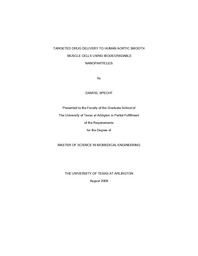
ATTENTION: The works hosted here are being migrated to a new repository that will consolidate resources, improve discoverability, and better show UTA's research impact on the global community. We will update authors as the migration progresses. Please see MavMatrix for more information.
Show simple item record
| dc.contributor.author | Specht, Danyel | en_US |
| dc.date.accessioned | 2008-09-17T23:35:09Z | |
| dc.date.available | 2008-09-17T23:35:09Z | |
| dc.date.issued | 2008-09-17T23:35:09Z | |
| dc.date.submitted | August 2008 | en_US |
| dc.identifier.other | DISS-2220 | en_US |
| dc.identifier.uri | http://hdl.handle.net/10106/1106 | |
| dc.description.abstract | Restenosis is a common problem that can occur in angioplasty patients. In order to reduce the restentosis rate, various treatments such as glucocorticoids and drug eluting stents have been used for angioplasty patients. However, their limitations include the inefficient delivery of drugs to inhibit smooth muscle cell proliferation, a major cause of restenosis. Therefore, we propose the use of biodegradable nanoparticles as a drug delivery system for transporting a therapeutic agent to human aortic smooth muscle cells (HASMC) to prevent their proliferation. In this study the glucocorticoid dexamethasone (DEX) was chosen as the therapeutic agent. A biodegradable polymer, poly (D,Llactide-co-glycolide) (PLGA) was used to formulate the nanoparticles through the evaporative emulsion technique. The mean nanoparticle diameter was found to be approximately 130 nm with a range of 88-190 nm. Various uptake studies were conducted to determine the optimal nanoparticle incubation time, dosage, and biocompatibility. Based on the results it was concluded that PLGA nanoparticles were biocompatible to HASMC, and the optimal time and concentration for cellular uptake were 4 hours and 800 µg/ml, respectively. Drug release studies indicated PLGA nanoparticles produced a sustained release of DEX. Over a period of 3 weeks about 12 % of DEX was released from the nanoparticles. HASMC proliferation studies conducted using DEX indicated that cellular proliferation is significantly reduce when using a DEX concentration of 100 nM or higher. Additional studies were performed to compare our DEX encapsulated nanoparticles against non-encapsulated DEX. The comparative studies suggested that PLGA nanoparticles encapsulated with DEX were more sufficient than free DEX (DEX added directly in the cell media) to inhibit HASMC proliferation. Lastly, the nanoparticles were ligand conjugated to PDGF-BB and compared against non-targeted nanoparticles. It was evident that the cellular uptake on non-targeted nanoparticles was significantly less than that of PDGF-BB targeted particles. Our results suggest that PDGF-BB peptide conjugated PLGA nanoparticles can be used as a targeted and controlled drug delivery vehicle to reduce the restenosis rate for patients who are undergoing cardiovascular interventions. | en_US |
| dc.description.sponsorship | Nguyen, Kytai Truong | en_US |
| dc.language.iso | EN | en_US |
| dc.publisher | Biomedical Engineering | en_US |
| dc.title | Targeted Drug Delivery To Human Aortic Smooth Muscle Cells Using Biodegradable Nanoparticles | en_US |
| dc.type | M.S. | en_US |
| dc.contributor.committeeChair | Nguyen, Kytai Truong | en_US |
| dc.degree.department | Biomedical Engineering | en_US |
| dc.degree.discipline | Biomedical Engineering | en_US |
| dc.degree.grantor | University of Texas at Arlington | en_US |
| dc.degree.level | masters | en_US |
| dc.degree.name | M.S. | en_US |
| dc.identifier.externalLink | https://www.uta.edu/ra/real/editprofile.php?onlyview=1&pid=1181 | |
| dc.identifier.externalLinkDescription | Link to Research Profiles | |
Files in this item
- Name:
- umi-uta-2220.pdf
- Size:
- 560.0Kb
- Format:
- PDF
This item appears in the following Collection(s)
Show simple item record


